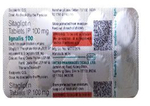sitanat (SITAGLIPTIN)
Introduction to sitanat
Sitanat is a medication primarily used to manage type 2 diabetes. It helps control blood sugar levels in adults and may also reduce the risk of cardiovascular events in patients... See More

What is Sitanat?
Sitanat is a medication used to manage blood sugar levels in adults with type 2 diabetes. It works by inhibiting the enzyme DPP-4, which increases the levels of incretin hormones. These hormones help increase insulin release and decrease glucagon levels, leading to better blood sugar control. Sitanat is used alongside diet and exercise, and sometimes with other diabetes medications.

What is the usual dose of Sitanat?
The usual daily dose of Sitanat for adults is 100 mg taken orally once a day. For patients with moderate renal impairment, the dose is reduced to 50 mg once daily, and for those with severe renal impairment or end-stage renal disease, the dose is 25 mg once daily. Sitanat is not recommended for use in children as its safety and effectiveness have not been established in pediatric patients.

How do I take Sitanat?
Sitanat should be taken once daily, with or without food, at the same time each day to maintain consistent blood levels. There are no specific food restrictions associated with Sitanat, but it is important to follow a balanced diet as recommended by your healthcare provider. Always follow your doctor's instructions regarding dosage and any additional dietary guidelines.

For how long do I take Sitanat?
Sitanat is typically used as a long-term treatment for managing type 2 diabetes. It is important to continue taking it as prescribed by your healthcare provider, even if you feel well, as it helps control blood sugar levels over time. Regular monitoring and follow-up with your doctor are essential to assess its effectiveness and make any necessary adjustments.

What disease or symptom is Sitanat used for?
Sitanat is indicated for the management of type 2 diabetes in adults. It is used to improve glycemic control in conjunction with diet and exercise. Sitanat can be used alone or in combination with other diabetes medications, such as metformin, sulfonylureas, or insulin, to help lower blood sugar levels and reduce the risk of diabetes-related complications.

How long does it take for Sitanat to start working?
Sitanat begins to work shortly after ingestion, but it may take several weeks to see the full effect on blood sugar levels. Regular monitoring of blood glucose and HbA1c levels will help assess its effectiveness over time. It is important to continue taking the medication as prescribed and maintain regular follow-up appointments with your healthcare provider.

Is Sitanat effective?
Sitanat has been shown to effectively improve glycemic control in adults with type 2 diabetes. Clinical trials have demonstrated significant reductions in HbA1c, fasting plasma glucose, and postprandial glucose levels when used as monotherapy or in combination with other diabetes medications. These improvements help manage blood sugar levels and reduce the risk of diabetes-related complications.

How does one know if Sitanat is working?
The benefit of Sitanat is evaluated by regularly monitoring blood sugar levels, including fasting plasma glucose and HbA1c. These tests help determine how well the medication is controlling blood sugar over time. Regular follow-up appointments with your healthcare provider are essential to assess the effectiveness of the treatment and make any necessary adjustments.

How does Sitanat work?
Sitanat works by inhibiting the enzyme dipeptidyl peptidase-4 (DPP-4), which slows the inactivation of incretin hormones. This leads to increased levels of active incretins, such as GLP-1 and GIP, which enhance insulin release and decrease glucagon levels in a glucose-dependent manner. This helps lower blood sugar levels in individuals with type 2 diabetes.

Who should avoid taking Sitanat?
Important warnings for Sitanat include the risk of acute pancreatitis, which can be severe and life-threatening. Patients should be aware of symptoms like severe abdominal pain. Sitanat is contraindicated in patients with a history of serious hypersensitivity reactions to the drug. Caution is advised for those with renal impairment, and dosage adjustments may be necessary. Monitoring for heart failure symptoms is also recommended.

Can I take Sitanat with other prescription drugs?
Sitanat may interact with insulin or insulin secretagogues, increasing the risk of hypoglycemia. A lower dose of these medications may be required when used with Sitanat. Additionally, caution is advised when using Sitanat with other medications that affect renal function, as it is primarily excreted by the kidneys. Always inform your healthcare provider of all medications you are taking to avoid potential interactions.

Can Sitanat be taken safely while pregnant?
There is limited data on the use of Sitanat during pregnancy, and its effects on fetal development are not well established. Animal studies have not shown adverse developmental effects at doses much higher than the human dose. However, due to the lack of human data, it is recommended to use Sitanat during pregnancy only if the potential benefit justifies the potential risk to the fetus. Consult your healthcare provider for personalized advice.

Can Sitanat be taken safely while breastfeeding?
There is no information on the presence of Sitanat in human breast milk or its effects on the breastfed infant. Animal studies have shown that Sitanat is present in rat milk. Due to the lack of human data, it is recommended to weigh the benefits of breastfeeding against the mother's need for Sitanat and any potential adverse effects on the infant. Consult your healthcare provider for personalized advice.

Is Sitanat safe for the elderly?
For elderly patients, no specific dose adjustment is necessary based on age alone. However, since Sitanat is excreted by the kidneys, and renal function can decline with age, it is important to assess renal function more frequently in elderly patients. This ensures that the dosage is appropriate and helps prevent potential side effects related to renal impairment.

How should I store Sitanat?
Sitanat should be stored at room temperature, between 68°F to 77°F (20°C to 25°C), and protected from moisture. It should be kept in its original container, tightly closed, and out of reach of children. Once the bottle is opened, the medication should be used within 6 months. Avoid storing it in the bathroom to prevent exposure to moisture.

Does Sitanat make people tired or drowsy?
Commonly reported side effects of Sitanat include headache, which may occur in some patients. If you experience severe or persistent headaches, it is important to contact your healthcare provider. They may adjust your dosage or suggest an alternative treatment. There is no specific mention of drowsiness, sleepiness, or fatigue as common side effects in the provided content.

Does Sitanat cause stomach upset?
Common gastrointestinal side effects of Sitanat include nausea and diarrhea. If these symptoms are severe or persistent, it is important to contact your healthcare provider. They may adjust your dosage or suggest an alternative treatment. Monitoring your symptoms and maintaining hydration can also help manage these side effects.

Does Sitanat cause weight gain?
Sitanat does not typically cause significant weight changes. In clinical trials, body weight did not increase from baseline with Sitanat therapy compared to a small reduction in patients given placebo. If you experience unexpected weight changes, consult your healthcare provider to discuss potential causes and appropriate management.

Does Sitanat cause headaches?
Headache is a commonly reported side effect of Sitanat. If you experience a headache that is severe or does not go away, it is important to contact your healthcare provider. They may adjust your dosage or suggest an alternative treatment. Over-the-counter pain relief may be used, but only after consulting with your doctor.

Does Sitanat limit driving?
Sitanat does not typically cause symptoms that would impair the ability to drive. However, if you experience side effects such as dizziness or severe headaches, it is advisable to avoid driving until you feel better. Always monitor your blood sugar levels, as both high and low levels can affect concentration and reaction times. Consult your healthcare provider if you have concerns about driving while taking Sitanat.

Is it safe to drink alcohol while taking Sitanat?
Drinking alcohol can affect blood sugar levels and may interfere with the effectiveness of Sitanat. It is important to discuss alcohol consumption with your healthcare provider, as excessive alcohol intake can increase the risk of pancreatitis, a serious side effect associated with Sitanat. Moderation and medical guidance are advised.

Is it safe to exercise while taking Sitanat?
Sitanat does not specifically limit the ability to exercise. However, it is important for individuals with diabetes to monitor their blood sugar levels before, during, and after exercise, as physical activity can affect glucose levels. If you experience any unusual symptoms while exercising, such as dizziness or fatigue, consult your healthcare provider for guidance.

What are Sitanat possible harms and risks?
Common side effects of Sitanat include headache, upper respiratory tract infection, and nasopharyngitis. Serious adverse effects can include acute pancreatitis, heart failure, and hypersensitivity reactions such as anaphylaxis and angioedema. If you experience severe symptoms like persistent abdominal pain, difficulty breathing, or swelling, seek medical attention immediately. Regular monitoring and communication with your healthcare provider can help manage side effects.
Available in 2 variations

Sitanat 50mg Tablet 10s
Sitagliptin (50mg)
strip of 10 tablets

Sitanat 100mg Tablet 10s
Sitagliptin (100mg)
strip of 10 tablets













.svg)
